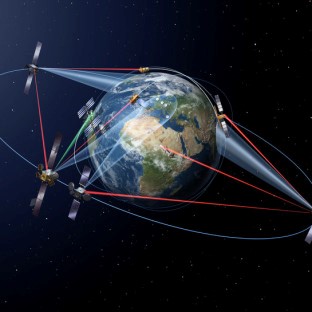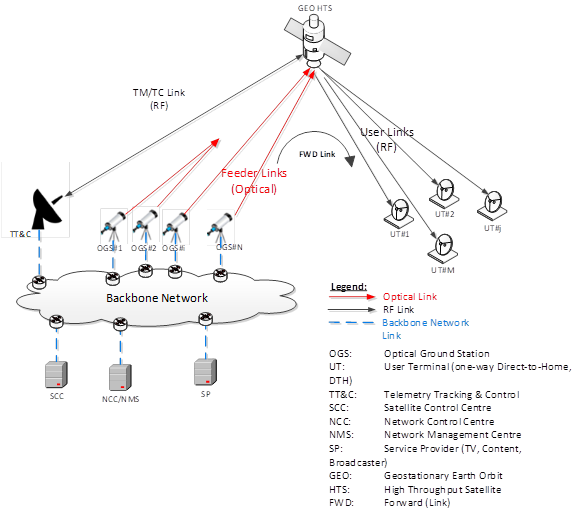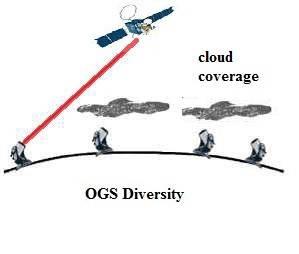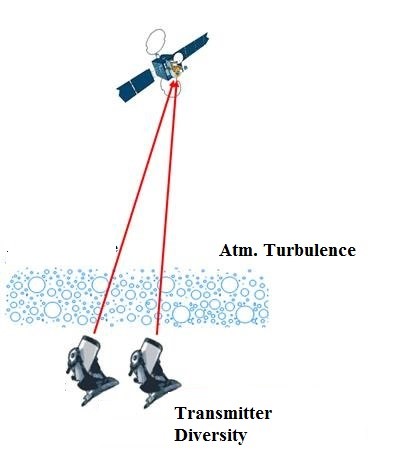Optical Satellite Communication Networks: Channel Modeling and Mitigation Techniques

Radio & Satellite Communications Group of ECE-NTUA that is led by Associate Professor Athanasios D. Panagopoulos is participating in European Space Agency’s Funded Projects: ONSET: OPTICAL FEEDER LINKS STUDY FOR SATELLITE NETWORKS & ONSET CCN.
In 2010 the European Union (EU) set 3 goals for broadband internet: a) all Europeans are provided with basic broadband (up to 30 Megabits per second, Mbps) by 2013 (achieved), b) all Europeans are provided with fast broadband (over 30 Mbps) by 2020 and c) the ultra-fast broadband (over 100 Mbps) for more than 50% of Europeans by 2020.
Even there is progress regarding the EU goals not all the Europe 2020 targets will be met. In order to try to reach these goals and in particular to make it financially affordable, satellite communications can play a key role, especially in sparsely populated, rural and remote areas. To meet these demands due to the limited spectrum of about 2GHz in Ka band, the new designed high throughput satellite communication systems are shifting to higher frequency bands. A promising solution is the employment of optical carrier frequencies for satellite communication. At optical range, very large bandwidth can be used with no limitations since there is no spectrum congestion.
The ONSET project is focused on the investigation of a GEO Optical Feeder link Scenario, as illustrated in Figure 1, which employs optical feeder links to the GEO satellite and Radio Frequency (RF) links for the user terminals. The main objectives of ONSET project are the investigation of key transmission technology enablers for the use of Optical Feeder Links and the development of software simulators for End-to-End performance evaluation.

Figure 1 ONSET system configuration
Optical links exhibit a variety of advantages in contrast with the RF systems, with prominent ones the higher bandwidth and higher data rates. However, the propagation of the optical link through the Earth’s atmosphere is mainly affected by clouds and atmospheric turbulence.
During this project, statistical and stochastic methodologies for modeling of cloud coverage and the effects of atmospheric turbulence in optical link reception have been developed. In addition, the Optical Ground Station (OGS) diversity technique for the mitigation of cloud coverage (Figure 2) and the small scale transmitter diversity technique for mitigation of atmospheric turbulence are examined (Figure 3). Finally, optimization algorithms for the selection of the minimum number of stations for the mitigation of cloud coverage and atmospheric turbulence are proposed.

Figure 2 Optical Ground Stations Diversity

Figure 3 Small Scale Transmitter Diversity
During the ONSET CCN project, experimental measurements from the ARTEMIS bi-directional optical link campaign conducted between the ESA’s OGS in Tenerife, Spain and the optical GEO satellite ARTEMIS are employed for the validation of the methodologies proposed and developed in the ONSET project. The validated methodologies can be used for end to end system level simulations of optical satellite links and the evaluation of fade mitigation techniques.
Principal Researchers for these activities are the NTUA ECE's PhD Candidate Mr. Nikolaos K. Lyras and the NTUA ECE's Post Doc Researcher Dr. Charilaos I. Kourogiorgas.
More details for the results of Radio & Satellite Communications Group research on Optical Satellite Communication Networks can be found in the following publications:
Peer Reviewed Journals:
[J1] Lyras N.K., Kourogiorgas C.I., Panagopoulos A.D., "Cloud Attenuation Statistics Prediction From Ka-Band to Optical Frequencies: Integrated Liquid Water Content Field Synthesizer," in IEEE Transactions on Antennas and Propagation, vol. 65, no. 1, pp. 319-328, Jan. 2017.
[J2] Lyras Ν.Κ, Kourogiorgas C.I, Panagopoulos A. D “Cloud Free Line of Sight Prediction Modeling for Optical Satellite Communication Networks”, in IEEE Communications Letters , vol.21, no.7, pp.1537-1540, July 2017.
[J3] Charilaos I. Kourogiorgas, Daniele Tarchi, Alessandro Ugolini, Nikolaos K. Lyras, Pantelis-Daniel Arapoglou, Athanasios D. Panagopoulos, Giulio Colavolpe Alessandro Vanelli-Coralli “Capacity Statistics Evaluation for Next Generation Broadband MEO Satellite Systems”, in IEEE Transactions on Aerospace and Electronic Systems , vol.53, no.5, pp.2344-2358, Oct.2017.
[J4] Alberto Mengali, Charilaos I. Kourogiorgas, Nikolaos K. Lyras, Bhavani Shankar M.R, Farbod Kayhan, Athanasios D. Panagopoulos, Thomas Baumer, Konstantinos Liolis “Ground-to-GEO Optical Feeder Links for Very High Throughput Satellite Networks: Accent on Diversity Techniques”, in International Journal of Satellite Communications and Networking, 2019.
[J5] Lyras N.K., Efrem C.N., Kourogiorgas C.I., Panagopoulos A.D. “Optimum Monthly-Based Selection of Ground Stations for Optical Satellite Networks” in IEEE Communications Letters vol. 22, no. 6, pp.1192-1195, June 2018.
[J6] Lyras N.K., Efrem C.N., Kourogiorgas C.I., Panagopoulos A.D. “Medium earth orbit optical satellite communication networks: Ground terminals selection optimization based on the cloud‐free line‐of‐sight statistics” in International Journal of Satellite Communications and Networking. 2018, 1–15. https://doi.org/10.1002/sat.1289.
Publications in International Conference Proceedings:
[C1] Lyras N.K., Kourogiorgas, C.I., Panagopoulos, A.D., "Cloud attenuation time series synthesizer for earth-space links operating at optical frequencies," in Antennas and Propagation in Wireless Communications (APWC), 2015 IEEE-APS Topical Conference on vol., no., pp.638-641, 7-11 Sept. 2015.
[C2] Lyras Ν.Κ., Kourogiorgas C.I., Panagopoulos A. D., “Joint Statistics of Cloud Attenuation induced on Multiple Optical Satellite Links”, 21th Ka band Conference, Bologna, Italy Oct 2015.
[C3] Lyras Ν.Κ., C. I. Kourogiorgas, Panagopoulos A. D. and Liolis K. P., “Monthly and Seasonal CFLOS Statistics for Optical GEO Feeder Links Design”, accepted for publication in 9th EAI International Conference on Wireless and Satellite Systems (WiSATS), 24-25 July, 2017, Oxford, Great Britain.
[C4] Lyras N. K.,et.al., “Optical Feeder Links Study towards Future Generation MEO VHTS Systems” 35th AIAA International Communications Satellite Systems Conference, 2017, Trieste, Italy.
[C5] Lyras Ν.Κ., Kourogiorgas C.I, Panagopoulos A. D. “Cloud Attenuation Prediction Statistics for GEO and NGSO Satellite Communication Systems Operating at Q/V Band and Above”, IET Conference Proceedings, 2018, p. 830 (5 pp.)-830 (5 pp.) EUCAP 2018 London.
[C6] Lyras Ν.Κ., Kourogiorgas C.I, Panagopoulos A. D., K. Liolis, Z. Sodnik “Experimental Optical Satellite Downlink Irradiance Statistics and Turbulence Conditions Estimation” IET Conference Proceedings, 2018, p. 903 (5 pp.)-903 (5 pp.), EUCAP 2018 London.
[C7] Lyras Ν.Κ., Kourogiorgas C.I, Panagopoulos A. D., Liolis K. and Sodnik Z. “On Aperture Averaging Effects for Central Obscured Telescopes: Experimental Validation with ARTEMIS Experimental Downlink Measurements” ICSO 2018 Chania.
[C8]Lyras Ν.Κ., Kourogiorgas C.I, Panagopoulos A. D., “Cloud Free Line of Sight Prediction for Low Earth Orbit Optical Satellite” ICSO 2018 Chania.
[C9] Lyras Ν.Κ., Kourogiorgas C.I, Kapsis T. and Panagopoulos A. D., “Ground-to-Satellite Optical Link Turbulence Effects: Propagation Modelling & Transmit Diversity Performance”, 13th European Conference on Antennas and Propagation (EUCAP), Krakow,2019.
[C10] Lyras Ν.Κ., Kourogiorgas C.I, Kapsis T. and Panagopoulos A. D., “On Optical Satellite Communication Systems Design: CFLOS Calculation and OGS Selection”, 13th European Conference on Antennas and Propagation (EUCAP), Krakow,2019.
